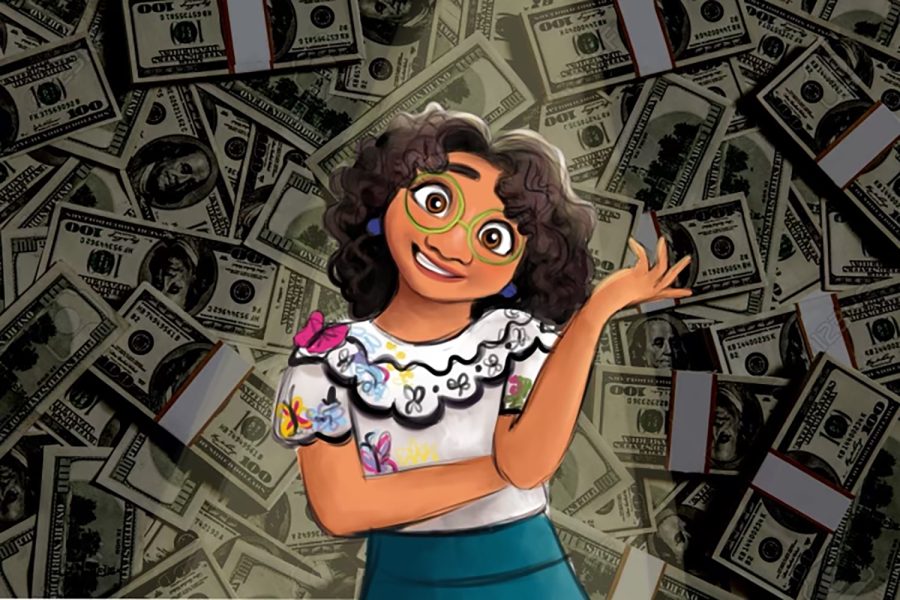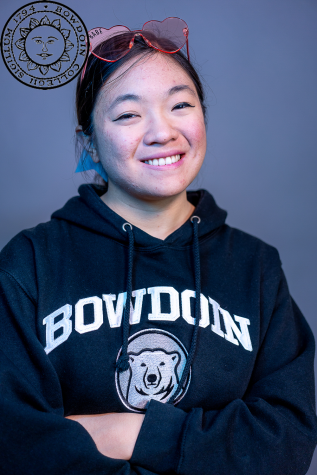Opinion: An Insidious Illusion
We must remain careful of how brands market themselves, no matter how much we agree with their messaging.
digital drawing by Kaitlin Chou
As in advertising, media corporations can easily take advantage of the current zeitgeist, all while seeming virtuous and well-meaning.
February 8, 2022
Everyone knows the joke: Disney owns everything. From Marvel to Star Wars to the princesses that popularized the company, Disney seems to have a hand in almost every new piece of media. The company has a long history of award-winning moviemaking, and these days, the company has raked in up to 2.02 billion USD in 2021 alone.
However, once social movements like #MeToo and Black Lives Matter came into the public consciousness, the company came under fire from activists. Particularly, Disney was criticized for their portrayal of women as victims in need of saving and depictions of racial stereotypes, such as Native Americans in Pochahontas and Black people in Dumbo.
One criticism was obviously easier to correct than another. Thus, Disney began its era of “girlboss” main female leads. Instead of the classical princess models that acted domestic and demure, women like live-action Jasmine and Enchanted’s Giselle began to take over. Disney became more meta, making jokes at the company’s own expense.
However, no matter how many feminist female leads Disney placed in their movies, executives were unable to erase the racism of the company’s past. Oftentimes, such as in the 2019 Dumbo movie, Disney ended up just pushing their racist caricatures under the rug, apparently ignoring their existence. This move, too, was later criticized, and the falseness of this new “era” of Disney movies was noted with distaste among activists, leading to older Disney movies being given a content warning.
Then, in 2016, Moana came out. It starred Auli’i Cravalho and Dwayne Johnson, two actors of Pacific Islander descent. It was an excellent movie, a combination of well-crafted animation, catchy songs, and a heartwarming story that represented and was based on Polynesian culture.
A few years later, Raya and the Last Dragon was released. It too had representation of cultures not usually brought to screen—specifically Southeast Asian cultures. Though it drew some criticism from viewers, it still received a 94% on Rotten Tomatoes.
Most recently, Encanto, a beautiful representation of Colombian culture, took social media by storm. Intensive details were put into the making of the movie—from character design to the music to the depth of each character. The story is heartwarming and genuinely lovely to watch, and Lin Manuel Miranda’s songwriting is as captivating as ever.
So what is the problem? Movies like Moana, Raya and the Last Dragon, and Encanto seem to be exactly what Disney was looking for—movies that represent marginalized groups without seeming false. They star actors of the same ethnicity as the characters; they are well-researched and wonderfully animated; they are clearly designed and produced with love.
And yet, they are not always directed by the people they represent. Encanto was directed by Jared Bush and Byron Howard, two men not of Colombian descent. Moana was directed by Ron Clements and John Musker, Raya and the Last Dragon was similarly directed by Don Hall, Carlos López Estrada, and John Ripa, three men not of Southeast Asian descent either. Disney seems to be taking advantage of the current zeitgeist and the modern, more popularized interest in representation—but what happens behind the screen?
It is easy to forget what Disney is—a corporation with a history of pay discrimination, one that has a record of labor violations, and one that is primarily headed by a group of white men.
Activism and representation in media are important, yes. But direct action to help the marginalized groups that companies like Disney take advantage of is even more important. Movies like Encanto are built on the backs of designers and artists immersed in Colombian culture, not the conglomerates that take the lion’s share of the credit.
Large corporations are always seeking to take advantage of viewers. The fact that a brand seems to reflect activist views does not mean it truly cares about inequality in the world. Corporations are built to make money, and if the appearance of activism increases viewership, then that is what they will aim for. We saw a similar, though considerably more pronounced, phenomenon in advertising years ago.
Needless to say, all of this is not to say that you cannot enjoy Disney’s new era of representation, but it is ever more important to spread the message of consuming media critically. Movies and television shows are first and foremost products to be sold, and it is important to remember who we are buying our products from.
_________________________________________________________________________________________
Editors’ note: All opinions expressed on The Uproar are a reflection solely of the beliefs of the bylined author and not the journalism program at NASH. We continue to welcome school-appropriate comments and guest articles.















Jason Verdin • Feb 11, 2022 at 8:45 am
I loved this piece. Thanks for sharing. I think because it is Disney, many people don’t look that deep at the directors. This was a HUGE issue a couple of years ago when American Dirt was published: a white woman trying to tell the story of migrant Mexicans seeking asylum in the US. Being Mexican-American, I was happy when at least one of the directors of Coco was of Mexican descent.